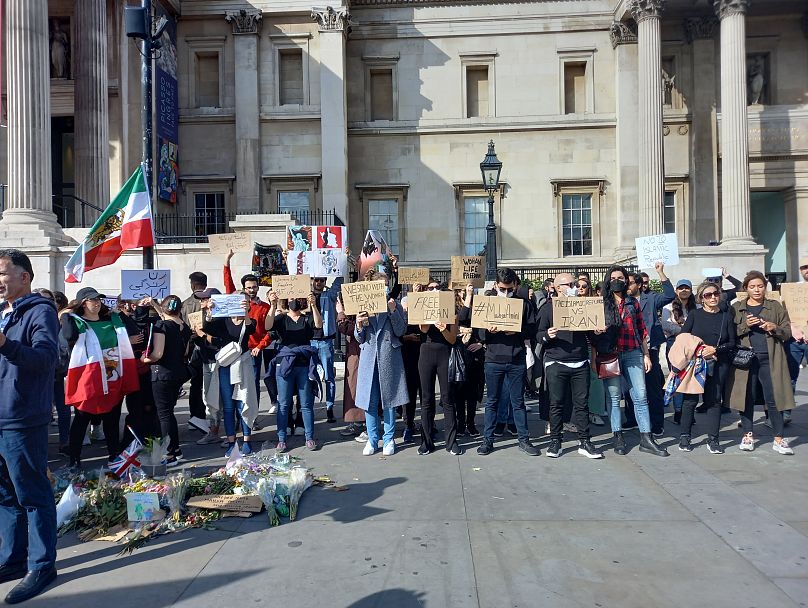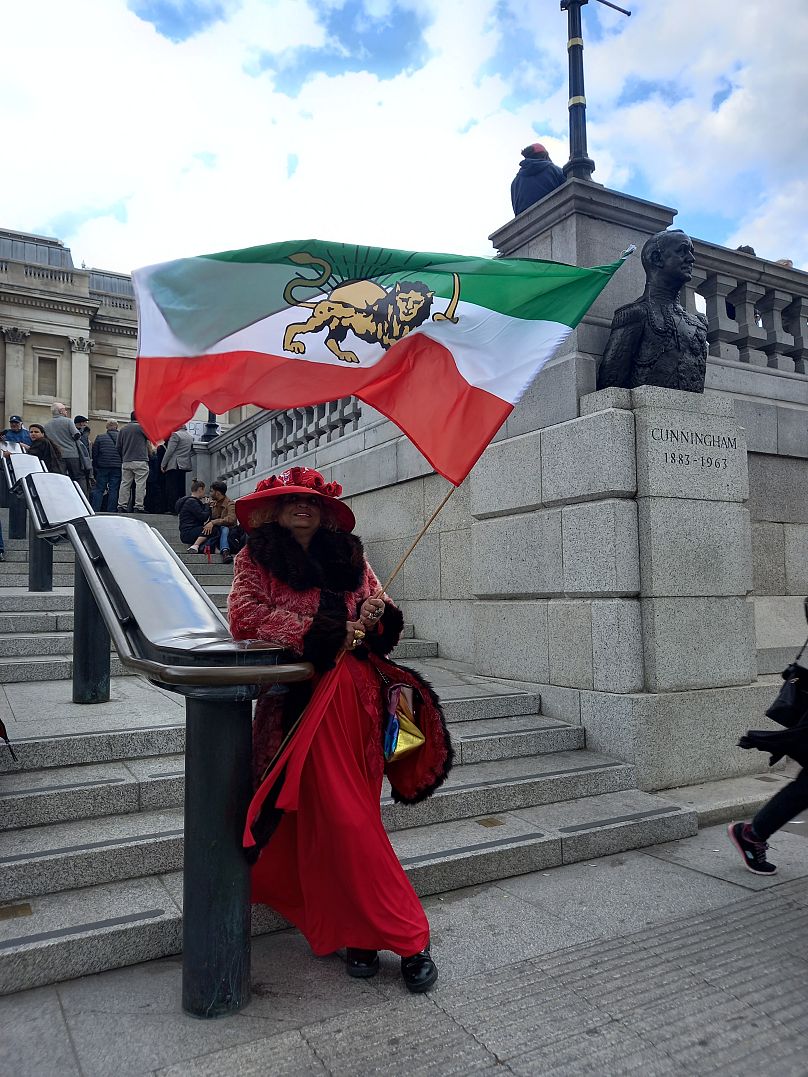"The regime wants to prove that they didn't use any violence [against Mahsa Amini] by using violence against protestors," said Mohammad Hoshr, a demonstrator in London on Saturday.
Hundreds of people protested in London this weekend to voice their anger about the suspicious death of Mahsa Amini, alongside the Iranian government's violent suppression of continued nationwide demonstrations back home.
Footage circulating online on Sunday appeared to show a group of protestors surging toward the Iranian Embassy in the UK capital but being beaten back by police.
A separate image shows the building, which overlooks Hyde Park, splattered with red paint.
"People are being killed, tortured and harmed in silence," Sepideh Eskandari, who protested at Trafalgar Square with her friend Sogol on Saturday, told Euronews.
"We are here to be their voice and ask every other person -- from wherever they are -- to stand with women."
"Basic rights are something everyone should want, both women and men," she added.
Deadly unrest has rocked Iran for more than a week. It broke out after 22-year-old Amini collapsed while in police custody, having been arrested for "improper" hijab, a headscarf women must wear by law.
Leaked medical evidence shows the young woman from the Iranian province of Kurdistan suffered several violent blows to the head, which put her into a coma, though Iran's authorities claim she "suffered a sudden heart attack".
She died on 16 September.
'It could have been your sister'
The two friends, who are both in their early 30s, pointed out that the protests are about wider issues of sexism and discrimination in Iran, something brought into sharp focus by Amini's death.
"As a woman, your rights are not equal to men," said Sogol. "You always have to suppress whatever you feel. You can't be truly who you are."
Following the 1979 Islamic Revolution, women must wear the hijab by law in Iran. The policy is largely unpopular, with Iranian women commonly wearing the headscarf loosely around their ears or letting it drop to the neck.
When the rule was implemented in 1981, it triggered mass demonstrations, which have continued sporadically ever since.
Another demonstrator in Trafalgar Square on Saturday told Euronews he was appalled by bloodshed in Iran.
"The regime wants to prove that they didn't use any violence [against Amini] by using violence against protestors," said Mohammad Hoshr, a lawyer. "It does not make any sense."
"They [Iran's authorities] are coming onto the TV and saying that nobody even touched this woman in custody, while at the same time they are shooting people on the streets," he added.
Some 35 people have been killed since protests broke out in Iran last week. The vast majority of these deaths have come from security forces violently suppressing demonstrators, using live ammunition in some cases. Hundreds of people have also been detained by security forces.
Officials in Iran have denied that security forces have killed protesters, suggesting they may have been shot by armed dissidents.
Hoshr called on the UK and other European countries to do more to support the protests.
"We want to UK government to put pressure on the Iranian regime. They should shut down the embassy to pressure them to bring those responsible for Amini's death to account."
"It is a short-term step, but the regime needs to answer for what they've done."
The UK government has sharply condemned the "killing" of Mahsa Amini, alongside other western countries, though there has been criticism over the fact that Iranian President Ebrahim Raisi was not publicly challenged on the issue during a recent UN meeting in New York.
"The Iranian government is so lacking in every aspect of humanity that they [western leaders] should keep away from them, rather than getting closer," Hoshr continued.
Iranian authorities have pledged to investigate the cause of Amini's death. Interior Minister Ahmad Vahidi has insisted she was not beaten, citing "evidence" from reports and forensic opinion. This is contested by eye-witnesses, Amini's relatives and activists.
'Ayatollah massacre'
Other demonstrators explained how the protests over the death of Amini have morphed into mass dissent against Iran's Islamic Government.
"This death has united people to topple the regime," said Hoshr. "It was a kind of spark that blew up all of our frustrations."
"Enough is enough," he added.
Many policies of the Islamic Republic of Iran, such as the compulsory hijab, are deeply unpopular among large sections of the Iranian population. Economic woes, especially inflation and a hugely devalued currency fuelled by sanctions, have only increased their frustrations.
A reformist group, the Union of Islamic Iran People's Party, has called for the mandatory dress code to be repealed and for "peaceful demonstrations" to be allowed, according to the BBC.
Chants against Iran's supreme leadership and the Islamic Republic have been a routine feature at this week's demonstrations, with many Iranians shouting "down with the dictator".
According to Hoshr, one prominent feature of the current unrest was a large number of very young people on the street protesting.
"In Iran, the young people do not have any aspirations because they [the government] kill their aspirations with all these rules and regulations," he said. "They desperately want change."
President Raisi, a hardliner, pledged on Sunday to "deal decisively" with the protests, which have now spread to most of Iran's 31 provinces. He has dismissed the protests as "riots".
"The regime thought the protests were going to be over in a day," said Hoshr. "But it hasn't."
"People are still on the streets."













